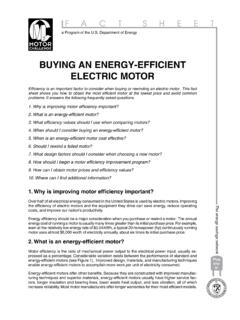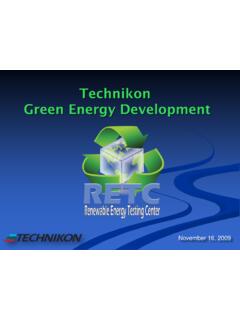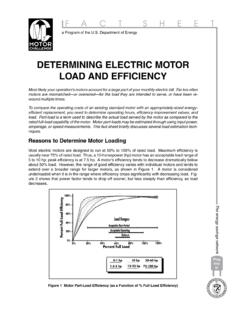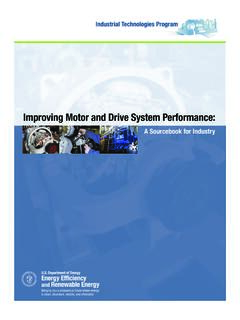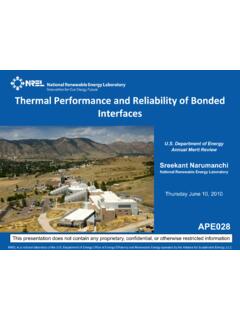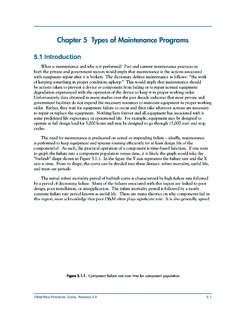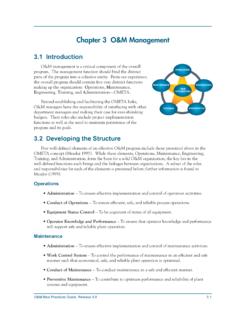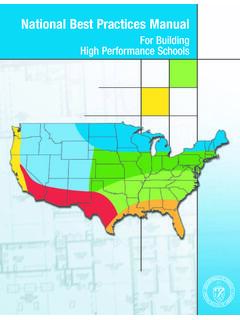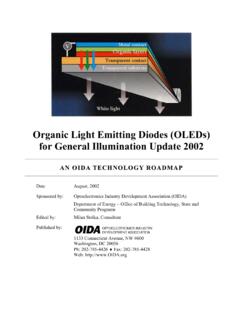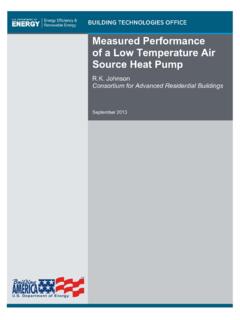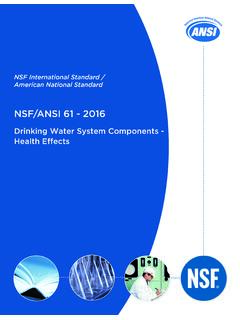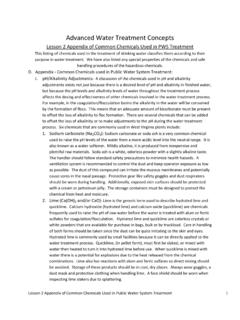Transcription of Reaction of Aluminum with Water to Produce Hydrogen
1 Reaction of Aluminum with Water to Produce Hydrogen A Study of Issues Related to the Use of Aluminum for On-Board Vehicular Hydrogen Storage Department of Energy Version - 2008 Page 1 of 26 CONTENTS EXECUTIVE SUMMARY .. 3 INTRODUCTION .. 5 BACKGROUND .. 5 Reaction -PROMOTING APPROACHES .. 6 Hydroxide Promoters Oxide Promoters Salt Promoters Combined Oxide and Salt Promoters Aluminum Pretreatment Molten Aluminum Alloys PROPERTIES OF THE Aluminum - Water REACTIONS RELATIVE .. 14 TO ON-BOARD SYSTEM PROPERTIES Hydrogen Capacities Kinetic Properties System Considerations REGENERATION OF Aluminum - Water Reaction PRODUCTS.
2 17 SUMMARY .. 19 REFERENCES .. 20 APPENDIX I THERMODYNAMICS OF Aluminum - Water REACTIONS .. 23 APPENDIX II ORGANIZATIONS PRESENTLY INVOLVED WITH .. 26 Hydrogen GENERATION FROM Aluminum - Water REACTIONS Version - 2008 Page 2 of 26 Reaction of Aluminum with Water to Produce Hydrogen John Petrovic1 and George Thomas2 Consultants to the DOE Hydrogen Program1 Los Alamos National Laboratory (retired)2 Sandia National Laboratories (retired) Executive Summary: The purpose of this White Paper is to describe and evaluate the potential of Aluminum - Water reactions for the production of Hydrogen for on-board Hydrogen -powered vehicle applications. Although the concept of reacting Aluminum metal with Water to Produce Hydrogen is not new, there have been a number of recent claims that such Aluminum - Water reactions might be employed to power fuel cell devices for portable applications such as emergency generators and laptop computers, and might even be considered for possible use as the Hydrogen source for fuel cell-powered vehicles.
3 In the vicinity of room temperature, the Reaction between Aluminum metal and Water to form Aluminum hydroxide and Hydrogen is the following: 2Al + 6H2O = 2Al(OH)3 + 3H2. The gravimetric Hydrogen capacity from this Reaction is and the volumetric Hydrogen capacity is 46 g H2/L. Although this Reaction is thermodynamically favorable, it does not proceed due to the presence of a coherent and adherent layer of Aluminum oxide which forms on the surface of Aluminum particles which prevents Water from coming into direct contact with the Aluminum metal. The key to inducing and maintaining the Reaction of Aluminum with Water near room temperature is the continual removal and/or disruption of this coherent/adherent Aluminum oxide layer. A number of Reaction -promoting approaches have been investigated for the Aluminum - Water Reaction . These include additions of hydroxide promoters such as NaOH, oxide promoters such as Al2O3, and salt promoters such as NaCl.
4 These additions act to disrupt the Aluminum oxide layer on the Aluminum metal. In addition, the Reaction of Water with molten Aluminum alloys such as Aluminum -lithium and Aluminum -gallium has been studied. In this case, the molten nature of the alloy prevents the development of a coherent and adherent Aluminum oxide layer. However, none of these approaches have proven commercially viable to date. The concept of using the Aluminum - Water Reaction to provide onboard Hydrogen for Hydrogen -powered vehicles presents a number of difficulties. First, storage systems using this approach will not be able to meet the 2010 DOE system targets of 6 Hydrogen and 45 grams Hydrogen per liter. Second, based on published Aluminum - Water Reaction rate kinetics, it appears Version - 2008 Page 3 of 26 difficult for this approach to meet the DOE minimum Hydrogen flow rate target for fuel-cell powered vehicles.
5 Finally, the cost of producing Hydrogen by this approach is dictated by the cost of Aluminum metal. The November 2007 commodity price for Aluminum is $ per kg. At this price, Hydrogen from an Aluminum - Water Hydrogen generation approach would cost approximately $21 per kg H2. Even assuming high volume production, the DOE target range for Hydrogen cost of $2-3 per kg H2 would not be met. Additionally, the supply of Aluminum required for mass market vehicle applications may be problematic. While Aluminum - Water Reaction systems cannot meet the targets for on-board vehicular Hydrogen storage, the use of Aluminum as a Water splitting agent for generating Hydrogen might have utility for non-vehicular applications. Version - 2008 Page 4 of 26 Introduction: The concept of producing Hydrogen by the Reaction of certain metals with Water has intrigued researchers for many years.
6 A paper by Smith in 1972 (1) described an approach using an amalgamated Aluminum surface which was based on even earlier work by others cited in the article. In a 1976 Patent, Gutbier and Hohne indicated that Hydrogen could be produced via the Reaction of magnesium- Aluminum mixtures with sea Water (2). More recently, there has been renewed activity, reflected in a number of publications and patents directed at the production of Hydrogen through reactions between Aluminum -based metals and Water . All of the Aluminum -based approaches propose methods to circumvent the protective layer of Aluminum oxide, thus allowing the Reaction with Water to proceed. The Hydrogen produced via such Aluminum - Water reactions might be employed to power fuel cell devices for portable applications such as emergency generators and laptop computers. There is also the suggestion that Aluminum - Water reactions might be used for Hydrogen storage on fuel cell-powered vehicles.
7 The purpose of this White Paper is to describe and evaluate the potential of Aluminum - Water reactions for the production of Hydrogen , primarily aimed at on-board Hydrogen -powered vehicle applications. We first discuss the Aluminum - Water Reaction and describe the various methods devised to maintain the Reaction . Then we consider the performance of such a system relative to the requirements for on-board vehicular Hydrogen storage. Since any Hydrogen generation concept, whether it is for on-board storage or not, will need to be regenerable (that is, the Reaction products will need to be returned to the initial form of Aluminum ), the energy and cost requirements for these processes will be discussed. Background: The following are possible reactions of Aluminum with Water : 2Al + 6H2O = 2Al(OH)3 + 3H2 (1) 2Al + 4H2O = 2 AlO(OH) + 3H2 (2) 2Al + 3H2O = Al2O3 + 3H2 (3) The first Reaction forms the Aluminum hydroxide bayerite (Al(OH)3) and Hydrogen , the second Reaction forms the Aluminum hydroxide boehmite (AlO(OH)) and Hydrogen , and the third Reaction forms Aluminum oxide and Hydrogen .
8 All these reactions are thermodynamically favorable from room temperature past the melting point of Aluminum (660 oC). All are also highly exothermic. From room temperature to 280 oC, Al(OH)3 is the most stable product, while from 280-480 oC, AlO(OH) is most stable. Above 480 oC, Al2O3 is the most stable product (3). See the Appendix I for a more thorough review of the thermodynamics of Aluminum - Water reactions. Version - 2008 Page 5 of 26 Table I: Thermodynamics of the Aluminum - Water Reaction . [The thermodynamic parameters as a function of temperature were calculated using HSC Thermodynamic Software, Version ] 2/3Al + 2H2O = 2/3Al(OH)3 + H2(g) T H S G oC kJ/mol H2 J/K kJ/mol H2 0 -277 -284 100 -284 -285 200 -291 -285 The Reaction thermodynamics shown in Table I indicate that Aluminum should spontaneously react with Water .
9 However, in practice a piece of Aluminum dropped into Water will not react under room temperature conditions, or even with boiling Water . This is because the Aluminum has a thin coherent, adhering layer of Aluminum oxide, Al2O3, on its surface and this alumina layer prevents the Reaction . So the key to inducing and maintaining the Reaction of Aluminum with Water at room temperature is the continual removal and/or disruption of the hydrated alumina layer. Organizations that are currently involved with the development of Aluminum - Water systems for the production of Hydrogen are listed in Appendix II. Reaction -Promoting Approaches: Hydroxide Promoters: A number of patents describe the use of hydroxides, primarily sodium hydroxide (NaOH), to promote Aluminum - Water reactions (4-8). There are two pertinent technical references on this subject. The first is by Belitskus (9).
10 Here, experiments were described in which Aluminum specimens including a cylindrical block, uncompacted powders, and pellets of various densities were reacted with aqueous solutions of sodium hydroxide at different concentrations to Produce Hydrogen gas at temperatures near room temperature. The formation of sodium aluminate was observed, as well as the regeneration of sodium hydroxide via the precipitation of Aluminum hydroxide. Stockburger (10) described Hydrogen generators in which Aluminum was reacted with an aqueous solution of M sodium hydroxide. The types of reactions found to occur between Aluminum , sodium hydroxide, and Water are shown below: 2Al + 2 NaOH + 2H2O = Na2Al2O4 + 3H2 (4) 2Al + 6 NaOH + xH2O = Na6Al2O6 + xH2O + 3H2 (5) Version - 2008 Page 6 of 26 2Al + 2 NaOH + 6H2O = 2 NaAl(OH)4 + 3H2 (6) 2 NaAl(OH)4 = 2 NaOH + 2Al(OH)3 (7) One of the problems with the use of aqueous NaOH solutions is the corrosive nature of the liquid, which can lead to corrosion of system equipment.
